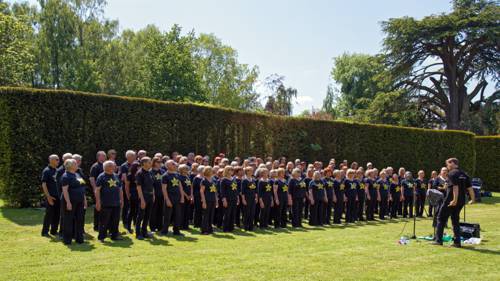
FAQ About The Cultural Significance of Contemporary Choirs

What defines contemporary choirs compared to traditional choirs?
Contemporary choirs often incorporate modern music genres such as pop, rock, and hip-hop, differentiating them from traditional choirs that focus on classical and sacred music. They tend to be more inclusive, welcoming diverse voices and providing creative expression through a broader range of musical styles. This flexibility allows contemporary choirs to engage with current social themes and movements.

How do contemporary choirs contribute to community bonding?
Contemporary choirs serve as hubs for community engagement by bringing together individuals of diverse backgrounds to share in the joy of making music. This collaborative environment fosters a sense of belonging and unity, allowing members to form social bonds through regular rehearsals, performances, and social events. The shared goal of creating harmonious performances encourages teamwork and mutual support among choir members.

In what ways do contemporary choirs reflect cultural expression?
Contemporary choirs reflect cultural expression by incorporating various music traditions and languages, allowing them to represent and celebrate diverse cultural identities. Their repertoire often includes songs that address current cultural themes, providing a platform for expressing social and personal narratives. By doing so, these choirs become ambassadors of cultural relativism and diversity, facilitating intercultural dialogue.

What role do contemporary choirs play in social movements?
Contemporary choirs can play significant roles in social movements by performing music that conveys powerful messages related to activism, justice, and societal change. They often participate in events and demonstrations, using music to inspire, unify, and galvanize audiences. These choirs provide a collective voice for communities seeking reform, contributing to the cultural landscape of activism through their performances.

Have contemporary choirs influenced popular music?
Yes, contemporary choirs have influenced popular music by collaborating with mainstream artists and incorporating choir elements into modern songs. This trend enhances the musical texture and emotional depth of pop music, making choir performances more accessible to wider audiences. Examples include prominent artists featuring choirs in live performances and recordings, bridging the gap between traditional choral music and contemporary soundscapes.

Can participation in contemporary choirs improve individual well-being?
Participation in contemporary choirs can significantly improve individual well-being by reducing stress, enhancing mood, and providing a sense of accomplishment. Singing in a choir has been linked to improved mental health due to the release of endorphins and the sense of community it fosters. Moreover, it offers personal growth opportunities, such as improved musical skills and increased confidence.

What challenges do contemporary choirs face?
Contemporary choirs may face challenges such as securing funding, accessing rehearsal spaces, and attracting diverse membership. Economic constraints can limit their ability to produce performances and participate in competitions. Additionally, they might encounter resistance from traditionalists who favor classical repertoire and hesitate to embrace contemporary styles. Navigating these challenges requires innovative approaches to maintain relevance and sustain operations.

How have digital platforms affected contemporary choirs?
Digital platforms have transformed contemporary choirs by enabling virtual rehearsals and performances, expanding their reach and accessibility. Online platforms allow choirs to connect with broader audiences and collaborate with artists worldwide, overcoming geographical constraints. This digital shift also provides innovative ways to showcase performances and engage communities, although it requires adapting to new technologies and addressing the lack of physical interaction.

What makes contemporary choirs appealing to younger generations?
Contemporary choirs attract younger generations by offering inclusive environments and diverse musical experiences that resonate with their interests. By blending various music styles and themes that address relevant social issues, contemporary choirs provide an engaging platform for self-expression. Additionally, the collaborative nature of choirs appeals to individuals seeking community-driven and innovative musical experiences.

Are contemporary choirs inclusive of all skill levels?
Contemporary choirs often emphasize inclusivity and welcome individuals of all skill levels. Many choirs do not require auditions, focusing instead on creating a supportive environment where members can learn and grow musically. This approach encourages participation from those who may not have formal music training but are enthusiastic about singing and contributing to a community-focused ensemble.

How do contemporary choirs differ around the world?
Contemporary choirs vary globally in terms of repertoire, style, and cultural influences. In some cultures, choirs may focus on integrating folk music, while others might blend urban and electronic sounds. The diversity of musical influences reflects regional traditions and the local societal context, enabling contemporary choirs to uniquely express and adapt to the cultural nuances of their surroundings.

What impact do contemporary choirs have on local culture?
Contemporary choirs impact local culture by commemorating historical events, celebrating cultural heritage, and promoting social awareness. By performing at community events and festivals, they highlight local stories and traditions, strengthening cultural identity and pride. Such choirs also function as cross-cultural bridges, enriching local scenes with global musical and cultural influences.

How do contemporary choirs incorporate technology into their performances?
Contemporary choirs use technology to enhance their performances by incorporating multimedia elements such as projection mapping, lighting effects, and sound augmentation. These technological integrations can create immersive experiences that engage audiences beyond auditory stimuli. Furthermore, recording and live-streaming performances can reach wider audiences, increasing accessibility and participation.

What are some examples of well-known contemporary choirs?
Examples of well-known contemporary choirs include the Soweto Gospel Choir, which fuses African gospel with various musical styles, and VOCES8, known for versatile performances ranging from Renaissance to contemporary genres. The Pentatonix, an a cappella group, also exemplifies contemporary choir innovation by incorporating pop elements and vocal harmonizations into their repertoire.

How can one join a contemporary choir?
People interested in joining a contemporary choir can start by researching local choirs via community centers, social media, or educational institutions. Many choirs have open rehearsals that allow prospective members to experience the choir environment before committing. Participating in these initial sessions provides insight into the choir’s style, community, and expectations.

Do contemporary choirs perform only modern music?
While contemporary choirs often feature modern music in their repertoire, they are not limited to these styles. Many choirs enjoy exploring classical, folk, and world music, valuing musical diversity and the ability to connect different eras and styles. This flexibility allows choirs to remain versatile and appeal to a broad audience base.

How do contemporary choirs support educational initiatives?
Contemporary choirs support educational initiatives by collaborating with schools and community programs to provide workshops, masterclasses, and education-focused performances. These initiatives aim to engage students with music education and promote creative expression, often facilitating increased access to music instruction and resources, particularly in underrepresented areas.

Are contemporary choirs used in therapeutic settings?
Contemporary choirs are increasingly used in therapeutic settings due to their benefits in stress reduction, cognitive enhancement, and social engagement. Music therapy programs leverage choir participation to support individuals with mental health issues, offering a safe and constructive environment for emotional expression and interpersonal connection.

How do contemporary choirs adapt to societal changes?
Contemporary choirs adapt to societal changes by updating their repertoire to include music that reflects current social themes and incorporating diverse musical influences. Engaging with technology and fostering inclusivity are other ways choirs address evolving societal dynamics. This adaptability ensures that they remain relevant, resonate with contemporary audiences, and contribute to cultural dialogues.

What is the future outlook for contemporary choirs?
The future outlook for contemporary choirs is positive, as they continue to thrive by embracing innovation, diversity, and community engagement. A growing interest in music and cultural expression suggests that choirs will remain important for social bonding and artistic exploration. The integration of digital platforms and new music styles will likely expand their reach and impact.
